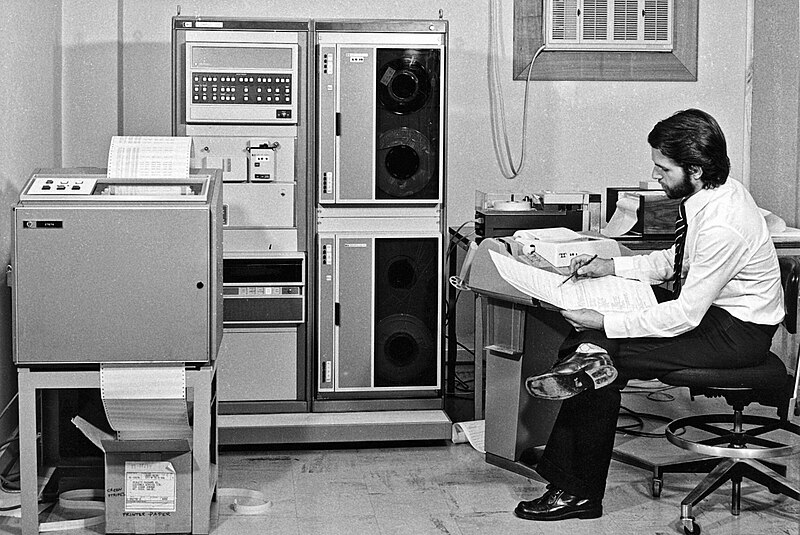Archivo:ESO Hewlett Packard 2116 minicomputer.jpg
De LibreFind
Saltar a: navegación, buscar

Tamaño de esta previsualización: 800 × 535 píxeles. Otras resoluciones: 320 × 214 píxeles | 640 × 428 píxeles | 1024 × 685 píxeles | 1280 × 856 píxeles | 5598 × 3744 píxeles.
Archivo original (5598 × 3744 píxeles; tamaño de archivo: 5,72 MB; tipo MIME: image/jpeg)
Este archivo es de Wikimedia Commons y puede usarse en otros proyectos. La descripción en su página de descripción del archivo se muestra debajo.
Resumen
| DescripciónESO Hewlett Packard 2116 minicomputer.jpg |
English: In this historical image, taken in 1974 in the ESO offices in Santiago, Chile, we can see the Austrian astronomer Rudi Albrecht, pencil in hand, poring over code in front of a teletype. He was working on software for the Spectrum Scanner attached to the ESO 1-metre telescope located at the La Silla Observatory. The data were processed in Santiago using the Hewlett Packard 2000F minicomputer which can be seen behind the printer. This bulky computer, with one processor and a breathtaking 16 kilobytes of magnetic-core memory (!), stored the results on magnetic tape, ready for further processing by visiting astronomers on computers at their home institutes. To handle files on tape that were larger than the available memory, Albrecht developed a virtual memory system, which he contributed to the Hewlett Packard Software Center. Please note that the computer in this image has been incorrectly identified by its original owner. The computer shown is a HP 2100 computer (2100A or 2100S), with two 7970 tape drives (7970A, B, C or E), 7900-series hard disk drive, 2748 paper tape reader and 2767A impact printer. |
| Fecha | |
| Fuente | http://www.eso.org/public/images/potw1223a/ |
| Autor | ESO |
Licencia
Este archivo se encuentra bajo la licencia Creative Commons Atribución 3.0 Unported.
- Eres libre:
- de compartir – de copiar, distribuir y transmitir el trabajo
- de remezclar – de adaptar el trabajo
- Bajo las siguientes condiciones:
- atribución – Debes otorgar el crédito correspondiente, proporcionar un enlace a la licencia e indicar si realizaste algún cambio. Puedes hacerlo de cualquier manera razonable pero no de manera que sugiera que el licenciante te respalda a ti o al uso que hagas del trabajo.
Leyendas
Añade una explicación corta acerca de lo que representa este archivo
Rudi Albrecht and a HP 2100 minicomputer, European Southern Observatory offices, Chile, 1974
Elementos representados en este archivo
representa a
4 jun 2012
Historial del archivo
Haz clic sobre una fecha/hora para ver el archivo a esa fecha.
| Fecha y hora | Miniatura | Dimensiones | Usuario | Comentario | |
|---|---|---|---|---|---|
| actual | 13:12 14 feb 2024 |  | 5598 × 3744 (5,72 MB) | C messier | full size |
Usos del archivo
La siguiente página enlaza a este archivo:
Metadatos
Este archivo contiene información adicional, probablemente añadida por la cámara digital o el escáner usado para crearlo o digitalizarlo.
Si el archivo ha sido modificado desde su estado original, pueden haberse perdido algunos detalles.
| Título de la imagen |
|
|---|---|
| Fecha y hora de la generación de los datos | 10:00 4 jun 2012 |
| Crédito/proveedor | ESO |
| Fuente | European Southern Observatory |
| Título breve |
|
| Palabras clave |
|
| Información de contacto |
Karl-Schwarzschild-Strasse 2 Garching bei München, , D-85748 Germany |
| Términos de uso |
|
| Versión IIM | 4 |
| Comentario de archivo JPEG | In this historical image, taken in 1974 in the ESO offices in Santiago, Chile, we can see the Austrian astronomer Rudi Albrecht, pencil in hand, poring over code in front of a teletype. He was working on software for the Spectrum Scanner attached to the ESO 1-metre telescope located at the La Silla Observatory. The data were processed in Santiago using the Hewlett Packard 2100 minicomputer which can be seen behind the printer (with two 7970 tape drives, a 7900 hard disk and a 2748 paper tape reader). This bulky computer, with one processor and a breathtaking 16 kilobytes of magnetic-core memory (!), stored the results on magnetic tape, ready for further processing by visiting astronomers on computers at their home institutes. To handle files on tape that were larger than the available memory, Albrecht developed a virtual memory system, which he contributed to the Hewlett Packard Software Center. |